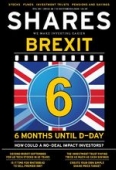Archived article
Please note that tax, investment, pension and ISA rules can change and the information and any views contained in this article may now be inaccurate.
City of London: 4.4% yield offers twice the return of best-buy cash accounts

Launched in 1891, City of London Investment Trust (CTY) has become one of the most popular investment trusts with investors seeking to run their own portfolios rather than use the services of financial advisers or wealth managers.
It is easy to see why the trust appeals to so many investors, in Shares’ view. City of London currently yields 4.4%, based on the past year’s dividend payout, an income return significantly better than you would get on cash in the bank at present. Furthermore, the trust has raised its dividend for 51 years in a row, so investors are enjoying a growing income stream.
To put that into context, the dividend yield is more than double the current best-buy one-year fixed term savings account, being ICICI Bank UK’s product with a 2.02% interest rate.
However, investors should always appreciate that investment trusts – and even individual company shares – aren’t obliged to keep paying dividends and they can cut or cancel payments at their own discretion.
THE INVESTMENT APPROACH
‘City of London’s investment style is value and income,’ explains fund manager Job Curtis. ‘Value, because share price valuation is the most important consideration of stock selection. And income, because we look at dividend yield first and foremost when we are valuing shares.
‘We take a long term view,’ adds Curtis. ‘My philosophy is partly valuation driven. Share price valuation is critical. But we’re looking for companies that have the cash flows not only to grow the dividend but also to spend on capital expenditure to grow the business.’
The investment trust has a bias towards FTSE 100 stocks
but investors also get exposure to a healthy sprinkling of
mid-caps and overseas investments. The latter include global healthcare giant Merck as well as technology titan Microsoft, purchased before current CEO Satya Nadella took over in the hot seat and helped drive a stellar performance.
Addressing the portfolio’s positioning relative to interest rate sensitivity, with the Bank of England having increased the base rate to 0.75%, Curtis points out ‘this is still an exceptionally low interest rate compared with the time that a lot of us remember’.
He points out that 10-year gilt yields are still fairly low at 1.3%. ‘Our portfolio of dividend-paying equities does look very attractive compared to the very low interest rates that are available in UK government bonds or in bank deposit accounts.’
MAJOR HOLDINGS
The portfolio is invested in high yield names including Royal Dutch Shell (RDSB) and BP (BP.) and lower yielders including publisher RELX (REL) and alcoholic beverages behemoth Diageo (DGE).
‘It is a blend,’ says Curtis, ‘but I do like my stocks to pay a dividend and almost all of our stocks have a yield of 2% or more. And I believe in running my winners,’ an exemplar being precision engineer Renishaw (RSW) which he describes as being an incredibly strong stock for the portfolio over the years.
It shouldn’t come as a surprise that City of London’s performance has been lacklustre this year, given its portfolio contains so many FTSE 100 companies. In the first eight months of 2018 the FTSE 100 declined by 3.3% in value. In contrast, City of London’s net asset value dipped by 0.7% according to Morningstar – slightly disappointing for investors but still outperforming the market.
Investors shouldn’t panic about such a short performance period. City of London’s longer term track record is far more impressive.
Over the past decade, it has delivered 10.4% annualised total return (share price gain plus dividends) versus 8% from the FTSE All-Share which is made up of the FTSE 100, FTSE 250 and FTSE Small-Cap indices.
Nonetheless, investors should always appreciate that no investment trust is guaranteed to achieve the same level of success in the future as it has done in the past.
PORTFOLIO MOVEMENTS
‘Diageo is a long term holding and it has been a great stock for me,’ says Curtis. He describes the Johnnie Walker whisky-to-Tanqueray gin producer as ‘one of our best companies in Britain, a world leader in Scotch whisky, and strong in America and emerging markets.’
In June this year, City of London purchased a debut stake in Carnival (CCL), the world’s largest cruise company.
‘We’ve never held Carnival before; cruising is a very competitive holiday but it is one area where it’s quite hard to see how they would be disrupted by Amazon,’ explains Curtis.
‘Cruising has quite a good demographic – it has been favoured by the ageing populations who like it – but Carnival does have brands for younger passengers as well. Carnival seems to be delivering on its profits and growth and if there was a setback in the oil price, that would be quite a good catalyst and in the portfolio it is quite a good hedge against (oil price beneficiaries) BP and Shell.’
Another new holding is wealth manager St. James’s Place (STJ). ‘It is operating at the higher end of the financial services market and is very much the leader in the UK,’ enthuses Curtis, attracted to the company’s fast-growing assets under management.
Curtis also believes the Real Estate Investment Trust (REIT) space is an interesting area and has put shareholders’ money to work with positions in British Land (BLND) and Land Securities (LAND). ‘Both are trading on discounts because of Brexit worries and the effect on the office market. And those discounts look very attractive to me.’ (JC)
Important information:
These articles are provided by Shares magazine which is published by AJ Bell Media, a part of AJ Bell. Shares is not written by AJ Bell.
Shares is provided for your general information and use and is not a personal recommendation to invest. It is not intended to be relied upon by you in making or not making any investment decisions. The investments referred to in these articles will not be suitable for all investors. If in doubt please seek appropriate independent financial advice.
Investors acting on the information in these articles do so at their own risk and AJ Bell Media and its staff do not accept liability for losses suffered by investors as a result of their investment decisions.
Issue contents
Big News
- Investors braced for potential dilutive equity fundraise from Sirius Minerals
- Will Unilever exit the FTSE 100?
- Second worst September start for US tech stocks in 10 years
- Are UK markets finally ready to shed their Brexit discount?
- Share price decline implies Debenhams is at death’s door
- Is this the beginning of the end for Whitbread?

 magazine
magazine











